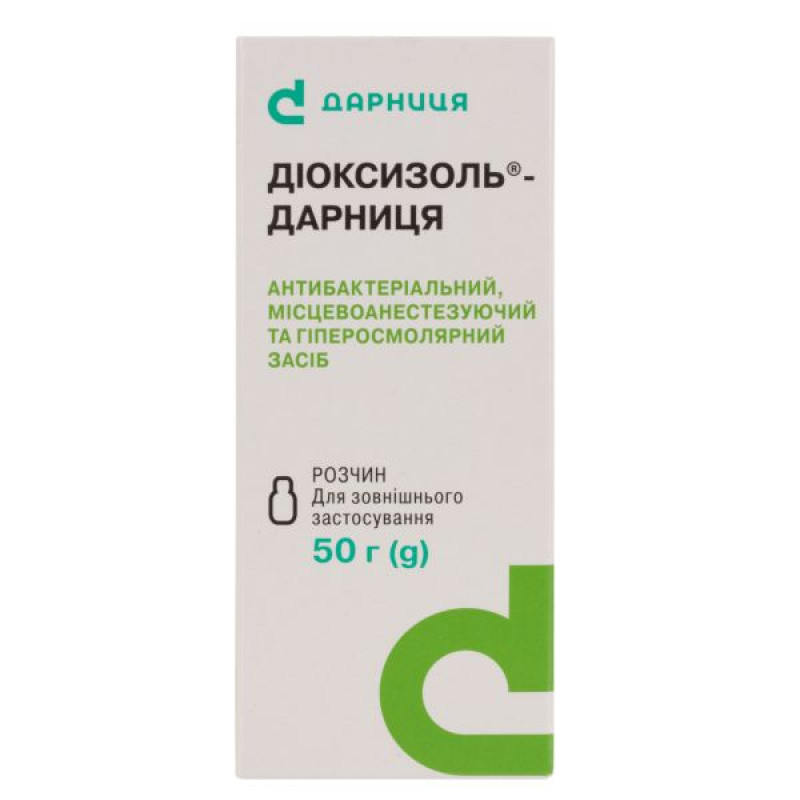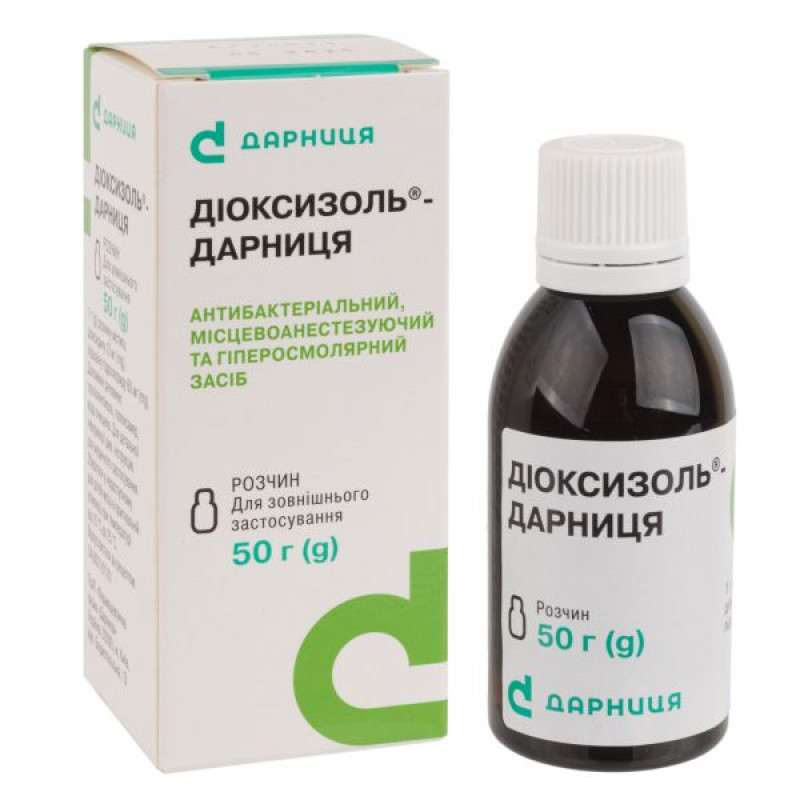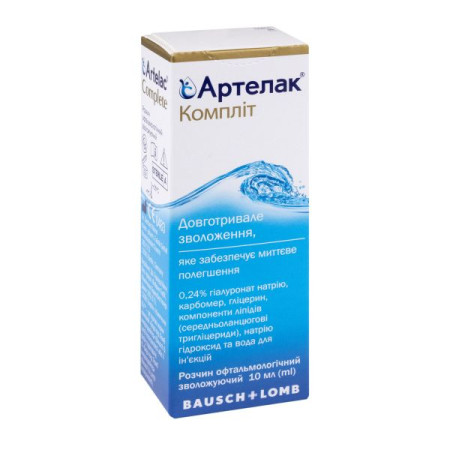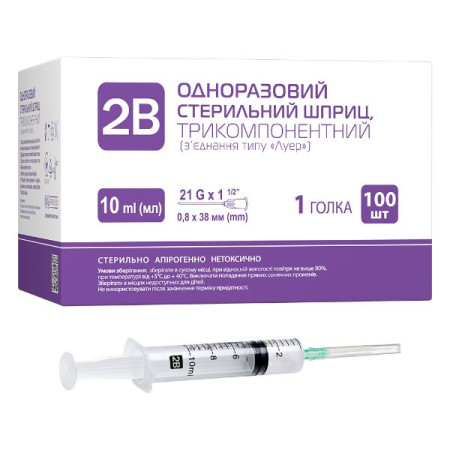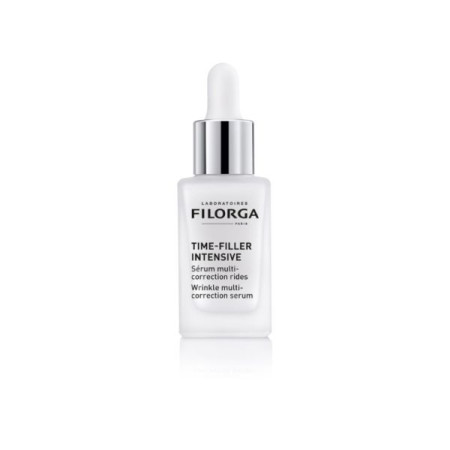Dioksizol-Darnitsa solution bottle 50 g
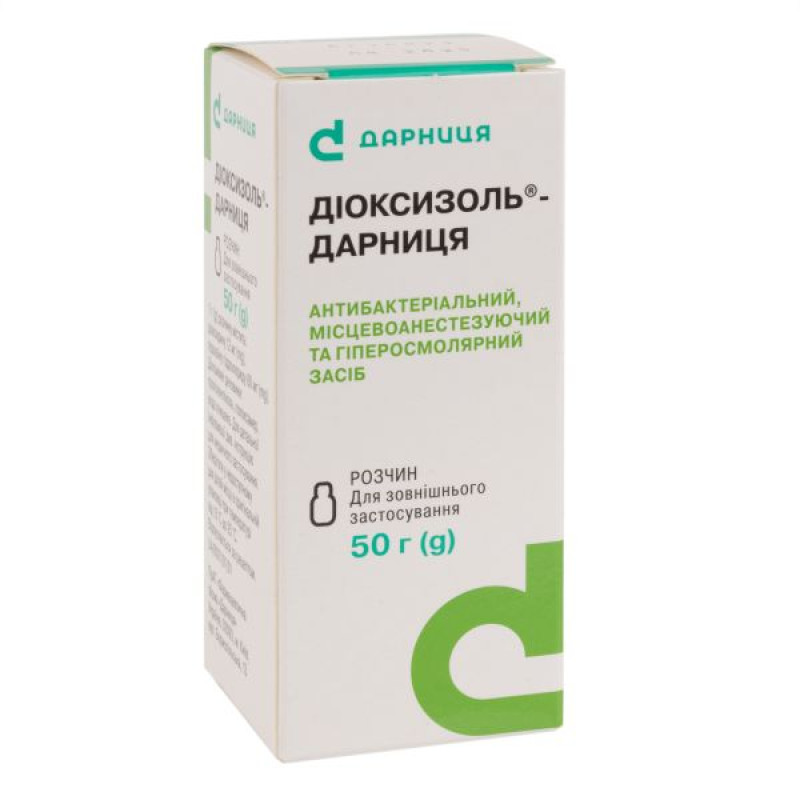
Instructions for Dioksizol-Darnitsa solution bottle 50 g
Composition
active ingredients: dioxydine, lidocaine hydrochloride;
1 g of solution contains: dioxidine 12 mg, lidocaine hydrochloride 60 mg;
Excipients: propylene glycol, poloxamer, purified water.
Dosage form
Solution.
Main physicochemical properties: transparent viscous liquid of light yellow color with a faint specific odor.
Pharmacotherapeutic group
Antibacterial agents. ATX code J01X X.
Pharmacological properties
Pharmacodynamics
Dioksizol®-Darnitsa is a combined drug for topical use, the active ingredients of which are dioxidine and lidocaine. The solution has a strong local anesthetic and moderate hyperosmolar effect, relieves wound and perifocal inflammation, stimulates repair processes and the activity of phagocytes in the wound.
Dioxidine has a pronounced antibacterial effect on gram-negative and gram-positive, aerobic and anaerobic, spore-forming and asporogenic microflora (pseudophila, staphylococci, streptococci, clostridia, bacteroids, peptococci, etc.) in the form of monocultures and microbial associations, including hospital strains of bacteria with multi-resistance to other antibacterial drugs. Its antibacterial action is based on the ability to damage bacterial DNA. As a result of such an effect, the synthesis of bacterial nucleases is slowed down, the ultrastructure of the bacterial cell is disturbed, the cell membrane thickens and the structure of the membranes is disrupted. The cytostatic effect of the drug is due to the effect on the sections of the genome responsible for the synthesis of exoenzymes that cause virulence, which is associated with the ability of the drug to prevent the development of resistance in microorganisms.
Lidocaine has a local anesthetic effect due to the blockade of voltage-gated Na+ channels, which prevents the generation of impulses in the endings of sensory nerves and the conduction of impulses along nerve fibers. When applied topically, it dilates blood vessels and does not have a local irritant effect. The effect develops 1–5 minutes after application to the skin.
Pharmacokinetics
Dioxidine is practically not absorbed when applied topically and does not have a local irritating effect. It is not metabolized or accumulated in the body. It is excreted by the kidneys.
The rate of absorption of lidocaine and the amount of active substance that enters the bloodstream depend on the dose, type, size and condition of the surface to which it is applied (skin or mucous membrane), as well as the duration of exposure.
Lidocaine is well absorbed when applied to mucous membranes and damaged skin and poorly when applied to healthy skin. The time to reach maximum concentration in blood plasma is up to 1 hour. 40–80% of lidocaine binds to blood plasma proteins. Penetrates through the blood-brain and placental barriers, into breast milk. Metabolized in the liver. The half-life of lidocaine is 1.6 hours. Excreted by the kidneys and with bile: 90–95% - in the form of metabolites, up to 10% - in unchanged form.
Indication
– Infected soft tissue wounds of various localization and genesis (amputation stumps of limbs, wounds after surgical treatment of purulent foci, bedsores, trophic ulcers, purulent postoperative wounds and fistulas, paraproctitis, abscesses and phlegmons of the maxillofacial region, etc.);
– burns of II–IV degrees;
– acute and chronic osteomyelitis;
– preparation of wounds for autodermoplasty;
– prevention of purulent-inflammatory processes in surgery and combustiology when performing various plastic surgeries.
Contraindication
– Hypersensitivity to the active substances or to other components of the medicinal product;
– arterial hypotension, bradycardia, atrioventricular block II–III degrees, cardiogenic shock, hypovolemia;
– adrenal insufficiency (including history);
– pregnancy and breastfeeding;
– childhood.
Interaction with other medicinal products and other types of interactions
The interaction of the drug Dioksizol®-Darnitsa with other drugs has not been described. However, it is not recommended to use the solution simultaneously with other drugs for topical use (ointments, creams, etc.).
Application features
The medicine should only be used under the supervision of a doctor.
Use with caution in patients with impaired liver function.
Use with caution in renal failure; reduce the dose in chronic renal failure.
Dioxidine is prescribed only for severe forms of infectious diseases or when other antibacterial drugs are ineffective, including cephalosporins of the 2nd–4th generations, fluoroquinolones, and carbapenems.
If adverse reactions or pigment spots occur, the dose should be reduced, antihistamines should be prescribed, and if necessary, the drug should be discontinued.
The drug should be used primarily in the first phase of the wound process, as well as in the second phase for granulating wounds with areas of necrosis and inflammation.
Uncontrolled use of dioxidine and dosage forms containing it is not allowed.
The medicine contains propylene glycol, which may cause skin irritation.
Use during pregnancy or breastfeeding
The drug is contraindicated during pregnancy or breastfeeding.
Ability to influence reaction speed when driving vehicles or other mechanisms
While using the medicine, you should refrain from driving or operating other mechanisms.
Method of administration and doses
Dioksizol®-Darnitsa should be used by adults topically and for injection into fistulas, wound cavities, and pockets.
Local application.
The drug should be used immediately after surgical treatment of wounds and burns, as well as in the further process of their treatment, while the wound surface should be cleaned of exudate and necrotic tissues. Sterile dressing material (gauze bandages or tampons) should be abundantly saturated with the solution and applied to superficial burns or inserted into deep wounds, then sterile wipes should be applied, which are fixed with a bandage or adhesive plaster. Dressings should be changed once every 7–14 days when treating burns, once a day when treating wounds.
In fistulas, wound cavities and pockets.
The drug should be administered through a drainage tube, catheter, or using a syringe (without a needle) 1–2 times a day, followed by application of a sterile gauze bandage.
Dosage and duration of treatment depend on the size of the damaged area, severity of the disease, tolerability of the drug and are determined by the doctor. At the same time, the daily dose of the solution for local application should not exceed 100 ml, for injection into the cavity - 50–60 ml. The course of treatment should not exceed 15 days.
If necessary, repeat the treatment course after 1–1.5 months.
Children
The medicine should not be used in children.
Overdose
In case of overdose, the side effects of the drug may be increased, including the development of acute adrenal insufficiency.
Treatment: drug withdrawal, symptomatic therapy.
Adverse reactions
On the part of the immune system:
With intracavitary administration of the drug or when exceeding doses, the development of systemic side effects due to the presence of dioxidine in the drug is possible: headache, dyspeptic disorders, chills, increased body temperature, convulsions, hypersensitivity reactions, photosensitization, angioedema, very rarely - malignant hyperthermia.
Systemic adverse reactions when using lidocaine as a local anesthetic occur very rarely. The cause of their occurrence may be the use of too large doses (more than 15 g) of lidocaine, rapid absorption of the drug, hypersensitivity, idiosyncrasy or reduced tolerance to lidocaine in some patients. Systemic adverse effects may manifest as excitation or depression of the central nervous system, depression of the cardiovascular system against the background of arterial hypotension, bradycardia and anaphylaxis, convulsions, tremor.
Skin and subcutaneous tissue disorders:
Hypersensitivity reactions, including itching, skin hyperemia, rash, urticaria, periwound dermatitis, swelling, pain and burning sensation at the application site, which disappear on their own after a few minutes and do not require discontinuation of the drug.
Expiration date
2 years.
Storage conditions
Store out of the reach of children in the original packaging at a temperature of 15 °C to 25 °C.
Packaging
50 g or 100 g in bottles or jars; 1 bottle or jar in a pack;
200 g or 500 g and 1000 g in bottles or jars.
Vacation category
According to the recipe.
Producer
PrJSC "Pharmaceutical Company "Darnitsa".
Location of the manufacturer and its business address
Ukraine, 02093, Kyiv, Boryspilska St., 13.
There are no reviews for this product.
There are no reviews for this product, be the first to leave your review.
No questions about this product, be the first and ask your question.




